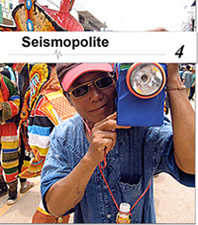September 30th, 2012
A moving image that can remember its past lives…
I. A moving image that can remember its past lives…
Thai contemporary art presents something of a problem for the student of new media art, since the most innovative and critical media thinking there tends to adopt media and art forms we would call neither 'new' nor 'experimental'. Wit Pimkanchanapong’s robotic sculptures, for instance, are made from components found in any hobby store. Navin Rawanchaikul’s media archaeology revives the declining arts of billboard painting and comic illustration. The most thought-provoking artistic peer-to-peer network, authored by Pratchaya Phinthong, was offline: a lounge in a gallery with a stack of art films on DVD, a stack of blanks, and a duplicator. Even Rirkrit Tiravanija, while hardly a ‘local’ artist, seems to fit this mould – his abidingly time-based practice runs the gamut of non-traditional media, but analogue forms (celluloid, performance) lie at the core of his aesthetic. The same tendency applies to the moving image: both the video performances of Araya Rasdjamrearnsook, and the animate cinema of Apichatpong Weerasethakul, show that formal renovation does not imply technical invention. [1]
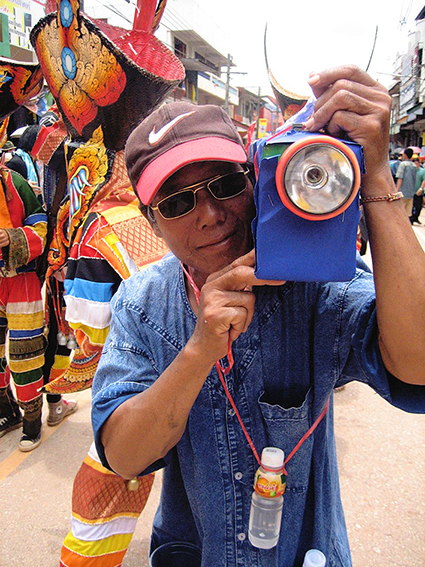
It’s little wonder, then, that techno-centric accounts of the field – such as those propagated by Leonardo, ISEA or rhizome.org – have struggled to plot places like Thailand onto their global maps. Access to new technology is hardly a problem for artists in Southeast Asia’s rapidly growing cities, but removed as they are from the cutting edge of IT research and development, their purchase on newer media is more often that of the consumer than that of the developer. Must they therefore be sidelined from the history of media art? Or should this situation prompt a recalibration of media aesthetics? We might, for example, emphasise low-tech over high-tech, remediations of old media over experimentation with the new. We might indeed revisit the question of the medium per se: instead of seeing it as a technical thing, we might consider it as a social process, focus on what it does, rather than what it is. Such an approach would put a medium’s relationship to older media at the centre of the analysis. It would mean attending not just to the contingent, local history of a given medium, but also to histories of mediation and mediumship that reach beyond the bounds of any single medium. It would demonstrate how, in technics, the past is immanent to the mediations of the present, sometimes irrespective of the content. And it would help to explain why the ‘program’ (Vilém Flusser) of this or that medium can be so different in places like Thailand to what it is in the West.
For media philosopher Bernard Stiegler, human memory – access to the past – is always already exteriorized, consigned to what Jacques Derrida calls “traces”, marks that are generalisable as writing.[2] But is memory exteriorized in this way in all cultures? If Stiegler is right that today’s technologies generalize – and, we might add, tend to globalise – this structure, then what are the implications for cultures differently equipped, as they are brought into the loop by, for example, digital photography or digital video? In Southeast Asia, oral and performance traditions exert a powerful influence over the moving image, even in forms and contexts that make no particular claim to that heritage. In this essay I will consider an encounter, in up-country Thailand, between digital video (DV) and a traditional festival, asking what sort of a vehicle video might be for collective memory and social history. But I’d like to begin this discourse on history with an anecdote, something Walter Benjamin once called the “extreme opposite of history”.[3]
II. The Ghosts of Dansai
In 2008, I found myself in the far-flung town of Dansai, nestled at the edge of the range overlooking Thailand’s rugged northeast, the region known as Isaan. I was attending the annual Phitakhon Festival with an Australian artist, Alex Kershaw, who was making an experimental videography of the festival.[4] Phitakhon, and the ritual calendar it culminates, attest to a prodigiously syncretic cultural matrix: vestiges of Brahmin practice, a legacy of the Indic civilisation ascendant in nearby Kamphuchea from the 9th century; some garden-variety Theravada Buddhist rites (which are Siamese/Lao, with origins in Ceylon); and underlying these, local animist practices – the Isaan dreaming – that articulate the bonds between the dead and the living, between sexual and agricultural fertility, between the community and their spirit-infested natural world.
For three days, all the community’s channels – human and environmental, spiritual and material, traditional and contemporary – dilate to channel the excesses of the symbolic economy. Most conspicuous is the famous mask, widely appropriated, nationally and beyond, appearing in brochures and in-flight magazines, on buses, websites and even phone cards, yet still the channel of a certain necro-phantasmatic performance, for a discourse with what Derrida called the plus d’un – the collective spirit of nameless forebears – in which the singular identity of the living is also effaced.[5] This explains the locals’ blasé approach to the mask, whose value consists in the making and the wearing, the collective becoming it enables, not in its material qualities or exchange value. Medium, not message, it is only a vehicle for other intensities. The same goes for the human media, the community centred around chief spirit medium Jao Por Guan, whose discourse with the ancestors gives the celebration its schedule and its law. Or for the fluid mediums, from the Mun River, home of the phra wet spirits, where the rites begin and end; to the ubiquitous lao khao (rice whisky) that lubricates the three days of relentless song and dance enveloping the ceremonies.
A raucous procession of ghosts jangles its way through town, cowbells and tin cans hitched to belts, amplifying the clangour. A water buffalo spirit charges through a crowd of revelers; a fisherman spirit angles in the stream of bodies; a helmeted flautist blows a PVC piccolo on the steps of the market.
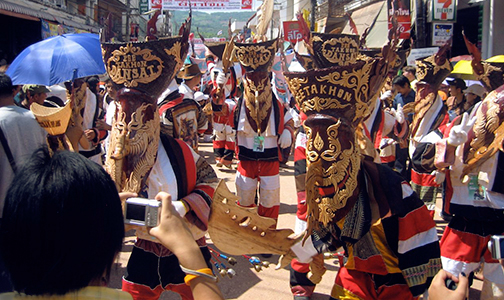
Sticks and stones, coins and cotton thread, food, music, floral arrangements – so many capillaries of merit. But these days, the proceedings are channeled beyond the community, too: by tourists and their snapshots, by anthropologists and musicologists, and by the promotional apparatus of the mass media, to regional, national and foreign audiences. In the temple grounds stands the Dansai Folk Museum, modest, earnestly informative. And deserted. How redundant this static, would-be archive feels, beside its rambunctious referent! The ghosts – traditionally only young boys but now including girls too – used simply to run amok, prodding unsuspecting townsfolk in the market, the playground, the street with their palaad kik, timber clubs, one end carved into a phallus, the other typically an axe-head. Human, animal, vegetable, mineral; aural, visual, tactile and performative – a whole synaesthetic taxonomy of the Tool. Do we have a media theory that could do justice to this dizzying range of media, this whole multi-faith arsenal of what Morris calls “indigenous technologies of transmission”?[6] Our attention is caught by a costume that stands out, a journalist spirit. He shimmies and weaves amongst the marauding ghosts, shouldering a homemade camera fashioned from cardboard and an old flashlight. Sensing the artist’s interest, he plays up to the lens – like the ghosts – by turns posing, and ‘filming’ the parade. It dawns on me only later that this ‘camera’ is not a simulated recording device, but an active channel – it’s his phi. He’s one of the ghosts, his performance is one with theirs, his disarming prop a spiritual prosthesis. So could we say the same of our artist, the troop of photographers up from Bangkok, or the slick TV crew from Hong Kong? How do Dansai’s mediums plug into these national and international channels?
Whatever the answer, surely it cannot be a one-way street. Are the tools we call ‘media’ also spiritually permeable? If the mask is, the cock/axe, the fishing rod, then why not the camera? But it is the inverse implication I’d like to pursue here: that the channeling going on in the celebration is itself a form of recording. Can we think of an archive consisting not in a recording towards reification, objective encapsulation or inscription; but in a reiteration that is gestural, subjective and social; one that defies (precisely, and for good reason), the precipitation of a static, objective form? Of course, we can: for historians of performance, and anthropologists, this is the sort of embodied archiving that dance and ritual performances achieve. The question is, can the moving image – that arch apparatus of capture, of inscription – partake of it? Might its inscription be somehow compatible with it? To what extent could a filmmaker be part of such a dance?
III. Isaan Carnivalesque, or, Society against the record
The great parade is in fact a relatively new channel, one that owes its current scale, if not its actual form, to shifts in a wider economy of appearances. In the 1970s, when it was initiated, provincial cultures were beginning to be valorized in national discourse in their own right, yet neither Phithakon nor better known provincial festivals show up in Thailand’s National Tourism Plan drawn up in 1975.[7] Isaan had only recently been plugged into the national communications grid, the region’s infrastructure (especially roads and telecommunications) built to service American military bases during the war in Vietnam. In 1976, when progressive political experiments in Bangkok gave way to a reactionary backlash, a brutal massacre at Thammasat University sent thousands of student protestors fleeing to the jungles of the northeast, swelling the ranks – and sorely testing the cohesion – of a long-running communist insurgency. State efforts to appropriate Isaan culture, spearheaded by the Tourism Authority of Thailand (TAT), began after a general amnesty was declared in 1982.
It was in the late 1980s that the festival outgrew the district (amphur) of which Dansai is the centre. Notably, this extension did not involve Bangkok. It took the form of an annual contribution – a kind of municipal tribute – to the Cotton Harvest Festival of the provincial capital (Loei), taking Phithakon out of season but reaching out to a wider, regional audience. A concession, perhaps, to the Spectacle ever gnawing away at the Festival, but hardly a debasement of the latter.[8] Indeed, ‘spectacle’ here warrants some articulation. Though in Thailand, as in Southeast Asia generally, both the establishment and post-war expansion of mass media were strongly shaped by authoritarianism – infrastructure dominated, where not monopolized, by state and military – recent decades have seen the devolution of this control. The rise of corporate broadcasting has brought some independence from the state, and plugged Thai media into wider, transnational information flows, and thus the agendas of other states.
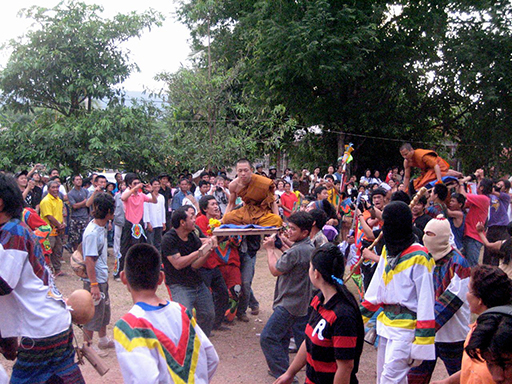
As a medium, the State itself is neither monolithic nor immutable. A wide array of authorities, passing under this sign, have over the years nudged and shoved Phithakon, not always in the same direction: royal, governmental, spiritual, museological; regulatory and promotional; central and parochial. Both state and media have sought to wrest the festival from its lunar, animist calendar, to anchor it in modern, linear time; and both have intervened to edit and embellish the stream of images it projects.[9] Kershaw’s ethnographic research – extensive interviews that were not part of his artwork – revealed local narratives of resistance to these attempts to co-opt and edit the festival. We are told through wry smiles how some traditions have offended official sensibilities. The TAT has taken special aim at the palaad kik penis amulets, apparently too lewd for a state promoting cultural tourism over the less wholesome varieties for which Thailand had long been famed. This symbolic castration may be the price of admission to national institutions – Phithakon figures appear often in state museums[10] – yet in Dansai itself, as we have seen, there seems no end to the prosthetic innovation through which the rites are propagated and renewed. If the state of Thai museum practice is any guide, tomorrow’s anthropologists will not be turning to the nation for insights into Phithakon’s extraordinary resilience.
The question of the record – whether a reified image of the past or some more dynamic mnemonic technique – is a pivotal one for historians of Southeast Asia. Theirs is a discourse of state formation, concerned first with the pre-modern ‘manpower states’ (based on wet rice cultivation) that from time to time emerged in the great river valleys; and second, in the modern era, with the constitution of nation states, on premises more or less tenuous or tenable, since colonization. In both phases, the state and the historical record are coextensive, indeed, virtually synonymous. Our image of the classical states is heavily filtered by writing – inscriptions in stone, or on palm leaves – a courtly technology, and whether used artfully or pragmatically, in any case bureaucratic. Performance cultures (including poetry, music, dance and ritual) are often adduced as a crucial accessory, but they too are centered on court traditions, formed at the core of the state ‘sphere of influence’. Modern history compounds the bias towards material vehicles of memory. Benedict Anderson’s study of nationalism, Imagined Communities (1983), for example – required reading for students of the region – is also a de facto media history. But its crucial emphasis on language and print media comes at the expense of performative and other non-objective forms that may have been the preferred channels, or in some cases a necessary last resort, for collective memory.[11]
More recently, scholars have begun to chafe at the limitations of this scriptural bias. James C. Scott, for example, imports the anthropological theory of Pierre Clastres.[12] In his elegant and persuasive Society Against the State (1977), Clastres argued that ‘primitive’ societies – a category long staked on a perceived lack of the state (and therefore of history) – remained as they did because everything they did, their institutions, rituals, social and economic organization, was designed precisely to prevent the state from forming. Rather than an incapacity to form states, Scott sees in the ‘fugitive’ societies of upland Southeast Asia (a zone of which Dansai sits on the southern fringe) a genius for state avoidance. Could we not apply the same inversion to our histories of media, to the enduring antagonism with which live, embodied, synchronic practices of remembering have resisted and evaded capture, reification and appropriation by diachronic, official history? For while the periphery’s political and territorial encompassment may be a fait accompli, as Scott suggests, the cultural homogenization (Clastres calls it ‘ethnocide’) is far from complete. Even if the vehicles of memory have been irrevocably modernized, the way they are used – the spirit of mediation, we might say – is not the same everywhere.
Visual anthropologist Rosalind Morris has written a captivating book about spirit mediumship in Thailand’s north, a performance tradition – though not, strictly speaking, ‘traditional’ – in which she reads a provincial polity’s response to being engulfed by Nation and modernity. Why has the northern spirit medium, who had eschewed photography studiously for its first half century in Siam, then embraced and integrated it so fervently in its second? What photography gives to the spirits, Morris explains, is not primarily the record, but the uncanny, “strange new powers” at the very moment their aura – their agency in what would come to be explained as, say, disease or accident – was challenged by science, capital and modernity.[13] Morris shows why we ought to be careful about importing, in our theories of photography, the latter’s propensities for that rationalised sort of vision it fairly stands for in the West. This holds a fortiori for the cinema, a new medium whose modernity could only be made legible when framed by the itinerant performance traditions that sheltered it, voiced it, and trucked it from village to village. The mobile nang krai yaa cinema was a regional, seasonal and above all live spectacle, responsive and permeable to the peripheral cultures it traversed.[14] To recognize the moving image’s historiographic capacity in such a context, we would surely have to look beyond its material traces – and beyond the ontology of celluloid – for a kind of record immanent to the act of mediation, a performative archiving.
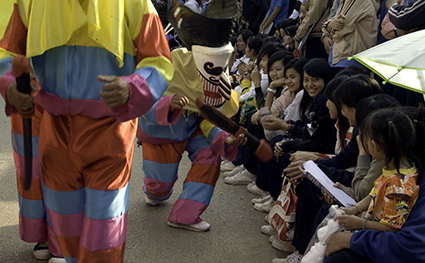
IV. Inheritance without Discourse
“The spirituality of … the visual image, whether that of Homo sapiens sapiens, of Lascaux, of the pictorial image properly speaking, that of the analog photographic image or of the analogico-digital image, is always already affected by the spirituality of the technology it looks at – from the vantage of a certain knowledge which it has of this technology.”
Bernard Stiegler, ‘The Discrete Image’[15]
It is often remarked that the presence of a camera alters the scene, an alteration that jeopardizes the veracity of an image once thought capable of registering reality in an only ‘indexical’ fashion. The apparatus, if allowed to go about its business with sufficient discretion, was thought to have had ‘affinities’ (Kracauer) with that reality: like life, it was time-based; and like us, it registered motion. The animate world was ideal pro-filmic fodder, as it was, so any animating on the part of the apparatus was somehow redundant and thus, according to some latent Platonic idealism, suspect. The staged or rehearsed – that is to say, performance – represented a threat to film’s privileged epistemological status. What Stiegler calls the “analogico-digital image” now promises to dissolve the indexical privilege, yet hasn’t saved us from the epistemological quandary. Debates about ‘observational’ and ethnographic filmmaking have underscored the need for a reflexive understanding of what the filmmaker does, of what he or she is doing there. Since Hal Foster’s prescient critique of the ‘ethnographic turn’ in the mid-1990s, artists working with non-art communities have had to find ways of underscoring their presence in the field of production.[16] Hence, Kershaw’s invitations to the people of Dansai to improvise with elements of their tradition. Not only does he foreground the camera’s impact as filter and catalyst; he also puts aside, ab initio, any prospect of an authoritative or ‘authentic’ account of the proceedings.
But what of the festival itself? What can we say about this other sort of transmission, this other archive embodied and exercised by the ghosts? First, that it consists only in its performance. Second, that it is open and dynamic, subject to change and revision – that it is contingent. Third, that it inscribes no origin; it is engaged not by repetition and the copy, but by reiteration. And fourth, that it is plural, produced collectively – perhaps not with multiple ‘authors’ (let’s hold at bay, if we can, this figure of an author that, in all its authority, haunts our own discourse) – but more in keeping with that collectivity that gives rise to the very event, inaugurated anew each and every year in the voice of Jao Por Guan, from neither script nor manual, in keeping with lore, not law, in a spirit of remembrance and perpetuity. From this point of view, if the archive is ‘live’ and not an object, there would be no difference between our videographer and the journalist spirit, between a recording and a mere performance of recording. No difference, that is, apart from the record, this supplementary trace or inscription.
Now the reader may have detected another figure haunting this discourse on the archive: the mal d’archive or ‘archive fever’ of Jacques Derrida. I am wary of disposing of one theoretical template (the cinema’s) only to replace it with another, also Western and even more universalising in its pretensions, that other machine of oral archiving or performative recording: psychoanalysis. Fail though we may to keep this spirit at bay, we should at least keep in view, with Derrida, both the impossibility of an archiving-without-record, without “substrate”; and Freud’s failure to form a proper concept of “that re-producible, iterable, and conservative production of memory, … that objectivizable storage called the archive.”[17] We would have to continue with only the “impression” of an archive, “the unstable feeling of a shifting figure, … of an in-finite, or indefinite process.” Now if this archiving is an inherently conservative operation – both institutive and conservative, says Derrida – it is in both respects oriented as much toward the future as the past, is even “the possibility and the very future of the concept [archive], the very concept of the future” upon which the archive depends.[18] This futurity is pivotal, especially for an archiving that yields no record. And if this describes well the performative memory of the ghosts, it also reveals how close we are to our own media-model:
“… the technical structure of the archiving archive also determines the structure of the archivable content even in its very coming into existence and in its relationship to the future. The archivization produces as much as it records the event. This is also our political experience of the so-called news media.”[19]
In a filmed discussion about the ‘cultural exception’ invoked to protect French cinema from Hollywood, Stiegler prompts Derrida to reflect on the matter of inheritance, on the protection of this “possibility of the future” by means of “localization”. Such inheritance, says Derrida, “always passes … by way of a filiation implying language … [It] institutes our own singularity on the basis of an other who precedes us and whose past remains irreducible… [T]he specter of this other regards us, concerns us: not in an accessory way, but within our own identity.”[20] Inheritance thus presents a paradox for a theory of media technics, since a “pure technics destroys inheritance" (as singularity), by repetition; but without technics, without this possibility of repetition or “iterability”, there is no inheritance.[21] What’s more, for there to be inheritance, it must be “tied to a name, to a language, possibly to a place.” But a curious thing happens as Derrida approaches the question of its form. He softens his earlier formulation (of a “filiation implying language”), thus:
“Every inheritance presupposes singular marks – I don’t dare say language or discourse any longer here … : I don’t want to exclude the possibility of an “animal” inheritance, … marks without discourse, places left to a future generation, or symbolically occupied… Every inheritance passes by way of singular marks, but … not necessarily by way of … language in the strict sense. These … marks are a challenge to technics, resistances to technologization, and they are at the same time (hence the tension) appeals to technical iterability, to tekhnë in the broad sense…”[22]
Does not Phithakon – the performance of the phi – exemplify just such an ‘inheritance without discourse’, and just this tension, appealing to mediation even while resisting it?[23] The ghosts neither speak nor inscribe. Instead, they wield in the Tool the very possibility of inscription, a potentiality suspended in play.
The ‘performative archive’ of Phithakon seems to know instinctively how to defend against attempts to reify it. It still sees relatively few foreign visitors; its schedule is still set by the spirits and announced in the voice of Jao Por Guan; and there’s no shortage of lascivious prodding, nor of ingenious new tools. Kershaw’s project highlighted the festival’s adaptive strength: when asked to improvise with their rituals, the villagers complied with insouciance, imagination and ease. The newest media technology could hardly pose a threat to such an inheritance. Indeed, our ghosts seem much more at home in the virtuality that, as Derrida says, marks and structures the event, “the time and the space of the image.” They might teach the media theorist who would think his time a thing or two about “the implications … of this virtual time,” about “what the new recalls of much more ancient possibilities.”[24]
David Teh works at the National University of Singapore, researching Southeast Asian contemporary art.
This article was originally published in PUBLIC, issue 44 (Toronto, Canada: 2011)
[1] May Adadol Ingawanij and David Teh, ‘“Only Light and Memory”: the permeable cinema of Apichatpong Weerasethakul’ (catalogue essay), Yang Fudong | Apichatpong Weerasethakul (Adelaide: Contemporary Art Centre of South Australia / Bigpond Adelaide Film Festival, 2011).
[2] Jacques Derrida and Bernard Stiegler, Echographies of Television: filmed interviews, trans. Jennifer Bajorek (Cambridge: Polity, 2002).
[3] Benjamin in The Arcades Project, quoted by Richard Sieburth, ‘Benjamin the Scrivener’ in Benjamin: Philosophy, Aesthetics, History, ed. Gary Smith (Chicago: University of Chicago Press, 1989): 23.
[4] Alex Kershaw, The Phithakon Project, 2008-09, originally conceived as a multi-channel video installation at GrantPirrie Gallery, Sydney, Australia. A later, single-channel iteration of the work was made for the 55th International Short Film Festival Oberhausen, Germany. The images accompanying this text are production stills reproduced by kind permission of the artist.
[5] This French expression means both more than one and no more one. Jacques Derrida, Specters of Marx, trans. Peggy Kamuf (New York and London: Routledge, 1994).
[6] Rosalind C. Morris, In the place of origins: modernity and its mediums in Northern Thailand (Durham and London: Duke University Press, 2000), 4.
[7] Tourist Organization of Thailand, Nation Plan on Tourism Development Final Report (Bangkok: Netherlands Institute of Tourism Development Consultants and SGV - Na Thalang & Co., Ltd, 1976).
[8] This suggests a certain revision of the opposition once posed by members of the College de Sociologie, in particular Roger Caillois, and later enshrined in Guy Debord’s magnum opus, The Society of the Spectacle (1967). See Caillois’ ‘Festival’ in Denis Hollier (ed.), The College of Sociology 1937-39 (Minneapolis: University of Minnesota Press, 1988).
[9] The state program of ‘civilizing’ the northeast, which is culturally and ethnically Lao, began with the internal colonization under King Chulalongkorn (Rama V, r.1868-1910). It was met with armed resistance. There is debate about how important cultural colonization was as a cause of revolt (as opposed to economic and political change) but at any rate culture was always a key channel for expressing it. Ever since, Isaan has generally felt the pointy end of the national imperative to homogenize what Thongchai Winichakul calls Siam’s ‘geo-body’, creating a tension that is no less palpable in Thai politics today. See Thongchai’s Siam Mapped: a history of the geo-body of a nation (Chiang Mai: Silkworm Books, 1994).
[10] Notable recent outings include the permanent installation at the Museum of Siam, and in the popular show Spirits: creativities from beyond (2010) at Thailand Creative and Design Center, both in Bangkok. In both exhibits, the festival’s Buddhist elements were emphasized, and the ghosts appeared unarmed.
[11] A new chapter (‘Census, Map, Museum’), added to the book’s second edition in 2006, underscores the museographical tilt. Benedict Anderson, Imagined Communities: reflections on the origin and spread of nationalism, 2nd edition (London and New York: Verso, 2006).
[12] James C. Scott, The Art of Not Being Governed: an anarchist history of Southeast Asia (New Haven and London: Yale University Press, 2009).
[13] Morris, op.cit., 195.
[14] Nang, the idiomatic word for movie, means ‘skin’, a usage deriving from the region’s puppet theatre traditions. The nang krai yaa (literally, ‘films to sell medicine’) was often staged for free at temple fairs, with revenue generated through the sale of herbal remedies during intermissions. Programmes comprised both Western and Asian movies, as well as local ones, and were typically voiced live, in the local language, by dubbers or ‘versionists’. See David Teh, ‘Itinerant Cinema: the Social Surrealism of Apichatpong Weerasethakul’, Third Text (forthcoming).
[15] Bernard Stiegler, ‘The Discrete Image’ in Jacques Derrida and Bernard Stiegler, Echographies of Television: filmed interviews, trans. Jennifer Bajorek (Cambridge: Polity, 2002), 159.
[16] Hal Foster, The Return of the Real (Cambridge, Mass.: The MIT Press, 1996).
[17] Jacques Derrida, Archive Fever: a Freudian impression, trans. Eric Prenowitz (Chicago and London: University of Chicago Press, 1996), 26.
[18] Ibid., 29.
[19] Ibid.,17.
[20] Derrida and Stiegler, Echographies, 86.
[21] Ibid., 87.
[22] Ibid., emphases mine.
[23] One notable characteristic of Phithakon is that although there’s plenty of ‘signification by exteriorisation’, writing per se is almost completely absent. Some of the Buddhist rites involve scriptures, but elsewhere, the only conspicuous writing is the names on the masks. As often in English as in Thai (both taught in local schools but neither, strictly speaking, native to the territory), these are chosen with an arbitrariness that if anything, suggests a denial of the written Word.
[24] Jacques Derrida, ‘Artifactualities’, in Derrida and Stiegler, op. cit., 6.









